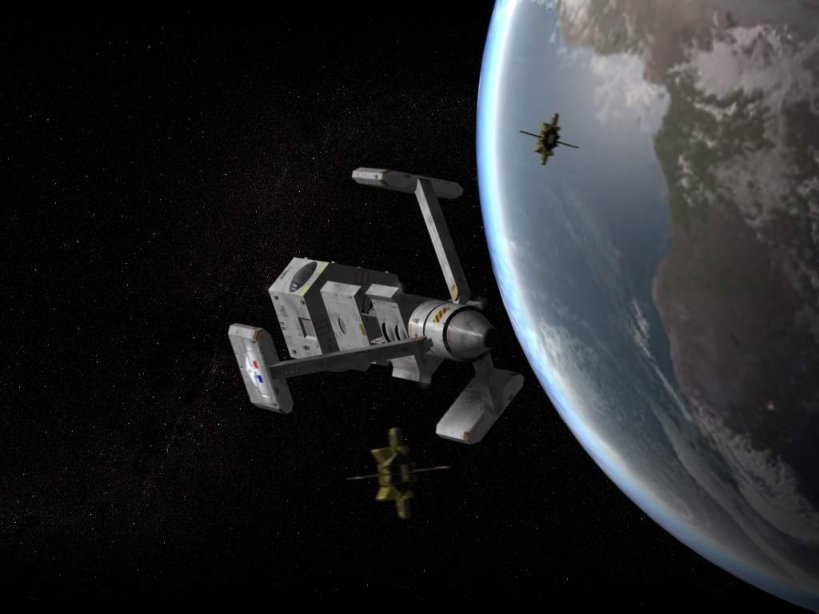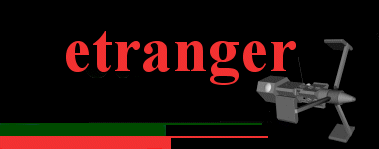
IFS Gloire
By Bryn Monnery, Laurent Esmiol and D Hebditch
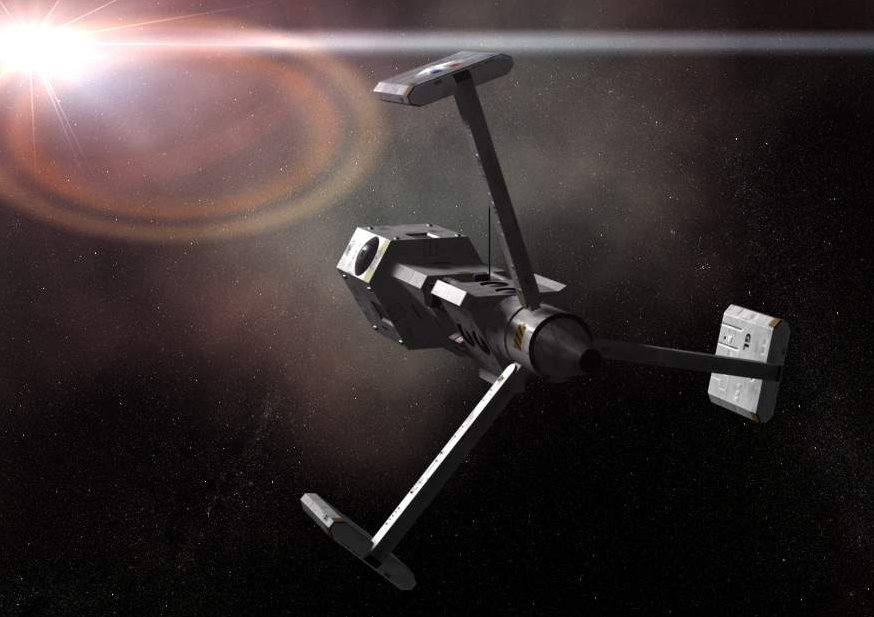
| Above: IFS Gloire
about to cross the FTL shelf and depart Sol
system for the Reserve Fleet at QAS Introduction The Gloire is one of the most modern of France's Suffren class of cruisers. The first of the second batch commissioned, integrating both the lessons of the Central Asian War and several new technological advances. Launched in 2289 she saw limited sparing during the war with Germany and was never deployed to the front at Aurore. However her time came at the Battle of Beowulf and later fleet actions. She now stands as a valued and prestigious part of Rochemont's Fleet. Acknowledgements This article is based on the Suffren class cruiser described in GDW's Star Cruiser and Mission Arcturus books. Narrative The Gloire tore towards the face of Kimanjano, her battle-scarred hull glinting in the light. Around her clustered a squadron of Martels, the survivors of the Kimanjano garrison and of Beowulf. They came in fast, experts all on the vagaries of the Kimanjano system, clearing the way for the big cruiser. The Gloire herself, pride of the 5th Fleet, followed her 'little friends' of the Lafayette, all batteries firing, frying anything in orbit it could reach. In the wake of the Gloire came more fighters and escorts from half a dozen nations screening the big assault ships; Verdun and Bir Hakeim, Iwo Jima and Blue Ridge. They held the first wave of the liberation forces, French and American marines together with Azanian paratroopers were packed into their armoured bellies. The cutting edge of the human counter-strike. But the Gloire held the Liberation's foremost vanguard. A mere two companies of picked men - tasked to take and hold their blocking positions at all costs. The first of American Marine Raiders; brash, burly, self-confident colonials. The second a forlorn hope from the Légion's Battalion of the Damned, a convict polyglot of killers. Taking them down were pilots of the Rapide Descente, France's finest - their bespoke, heavily armed landers replacing the Gloire's own. The Gloire's captain was under no illusion about the risks of her mission. Insert her troops and support them and the main wave from orbit for as long as possible. The unspoken task; to provide a target for the Kafers orbital defences, to draw them from the assault ships was also one she was prepared for. Sometimes risks just had to be taken. |
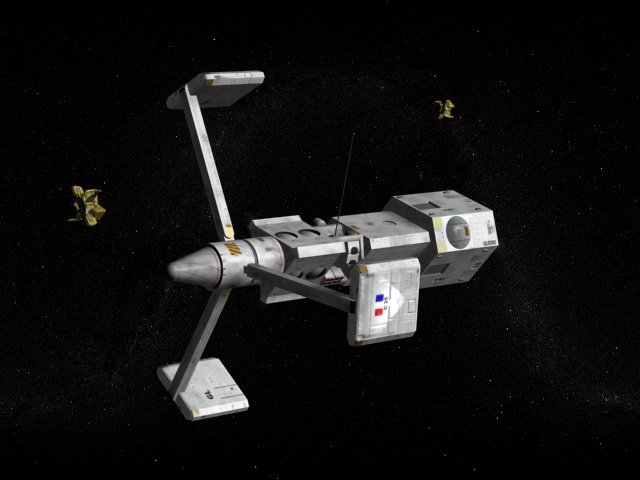
| Above: A
pristine Gloire newly emerged from
refit above Tirane about to start work up trials
The Suffren class was one of the first of the new wave of fast, well armed, multi-purpose warships that came into service in the last thirty years of the 23rd century. The Suffren's were to be the centrepiece of French interstellar force projection, being capable of long duration missions whilst carrying a half-battalion of troops. At the time this enabled the ship to be capable of virtually any volume supremacy and colonial troubleshooting mission. They could work alone or with a flotilla of other vessels. The first of the Suffren's entered service with the Marine Spatiale Française before the Central Asian War and was followed by four more before the end of the decade. The Suffren's, like most of the MSF, had a disappointing war trying to hunt down Manchurian raiders and privateers. The Suffren and Bassompierre were deployed onto the Chinese Arm and launched several planetary raids using their embarked troops. Unfortunately the Suffren's had problems in hunting down their elusive opponents. Worse was to follow when the De Grasse was utterly outmanoeuvred by Elysian privateers in the 61 Ursae Majoris system and was forced to withdraw allowing resupply of the rebels. Nevertheless the MSF was pleased overall with the design and a second batch was ordered to build on the lessons of the first as well as bringing in new equipment which would eventually be re-fitted onto the Batch 1 Suffrens. Batch 2 was to include new shields developed by Darlan SA to increase the already formidable protection on the warship and a revamped sensor suite. Direct fire weaponry was re-jigged and control systems for the new DA-2290 missile systems added. The Batch 2's would later receive the Ritage-2 system during their 10 year refit program. The lead ship of batch 2 was christened the Gloire after she emerged from the yards above Tirane. At first it seemed she would not live up to her name, but the events of the later years of the Kafer War proved the doubters wrong. |
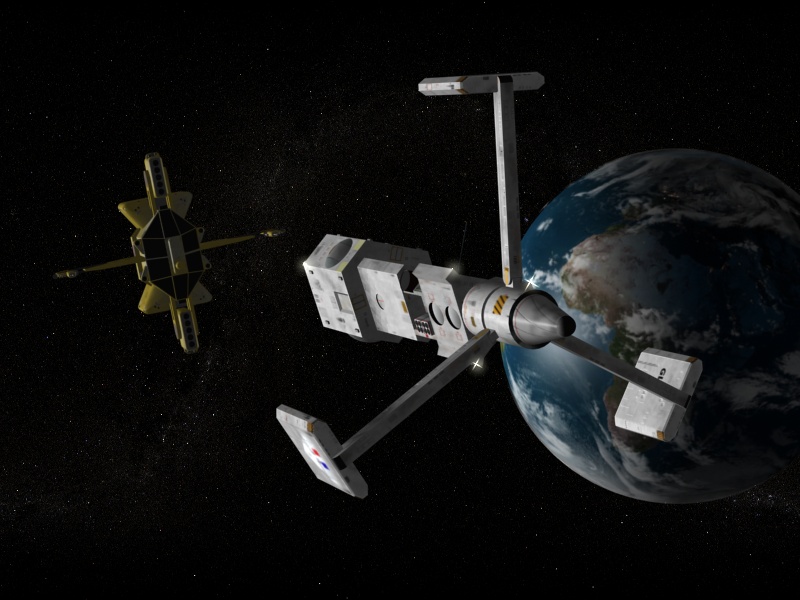
| Above: Gloire
about to transition to action stations whilst
on operations at Sol with the 1st Fleet in the mid '90's.
At this time tensions were still high and all major
French ships were operating with fighter escorts
The Gloire shares a common layout with the rest of the Suffrens. It retains the bow mounted auxiliary power system in spite of some concerns about its redundancy, and it has yet to be used in anger. Nevertheless the furled solar power system gives the nose of the Gloire its distinctive swirled aspect. To the rear of this is the spin and de-spin machinery required to rotate the ship's three spin habitats. These are supported on three arms spaced equally around the spin collar. Each is capable of holding around 165 personnel, normally a section of the crew, a troop company and a special section. The last is either the medical bay, scientific section or the rarely-used brig. The spin habitats are designed to be de-spun and lowered along the body of the ship to decrease its profile. This can be carried out in around 5 minutes on a well drilled ship, although if standards of stowage are poor it can take up to half an hour. Below: Original computer configuration models for the Suffren Class
Aft of the spin collar the ship assumes a triangular profile. The first section contains the bridge from which the captain controls the ship. Also in this section is the ship's security station which is under the control of a 20 strong detachment of FUVOLMARS. Security's job during combat is to secure the ship against possible boarding, to conduct boarding operations (often in co-ordination with embarked troops) and to reinforce damage control parties. When the ship is in station the physical and data integrity of the vessel is the responsibility of the detachment commander. There is also a small zero-G science lab in this part of the ship. The next part of the ship contains the 'tactical action centre' where the sensor operators, gunners and remote pilots work. Under the command of the Officier Opérations Spatiales (OOS) they are responsible for fighting the ship to the Captain's orders. Engineering includes the workstations required to keep the ship's engines and systems running perfectly. In addition there are an number of workshops and stores to enable the engineering team to conduct routine repairs and patch battle damage. Heavy stores for embarked troops can are normally found in this location. When the spin habitats are folded down they lock on to the outside of this section and access to them is only through engineering. The final section is dedicated to the ship's massive powerplant and drives. However the rear hull also contains the magnetic slings for the ship's 3 shuttle craft. |
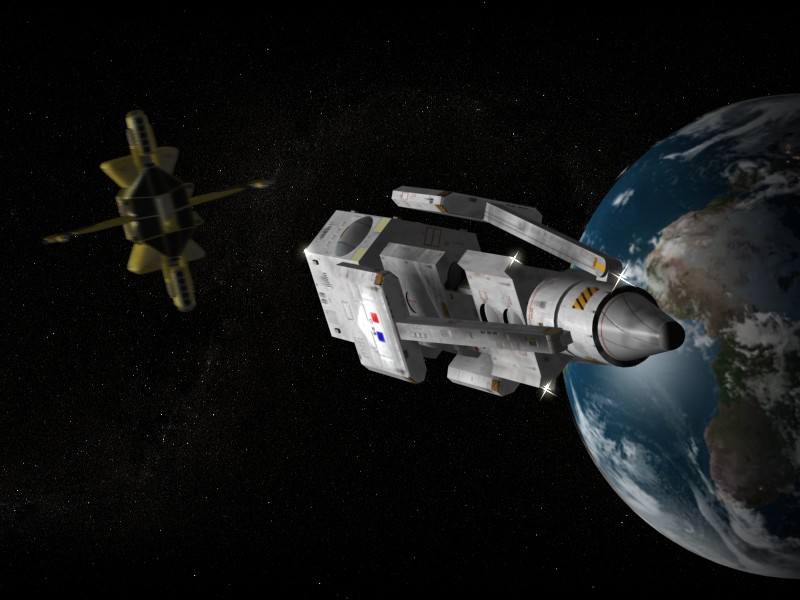
| Above: A
further shot in the sequence of Gloire
going to action stations. Note the spin habitats nearly
closed down and about to mate with the Engineering
section
The French learnt several lessons from their recent wars and have applied them to their modern ship designs. Prior to the Central Asian War, the French had their "Big Ship" philosophy. This stressed the use of ships as individual units rather than fleets, and all vessels were to be largely self-reliant and were built much larger than their equivalents from other nations. The Suffren is an obvious example of this, and the Gloire continues this school of thought, but it has very much been refined. The French no longer view vessels as separate entities, and have adopted a squadron system. Most squadrons will have a number of large ships like the Gloire at their core as the primary combat arm supplemented by a number of destroyers for long range striking power and frigates for defence and piquet duty. If available, fighters will be deployed at scout ahead of the main formation and deliver a first strike to weaken the enemy. In combat, the French doctrinoe stresses close offensive action against a weakened opponent. Typical French tactics would be to throw forward a wall of missiles to disrupt and weaken the enemy, charging in with guns blazing once sufficient damage had been inflicted. Active sensors would be committed once the enemy has launched their first attack, as there is nothing to loose at that point. If outmatched, they would throw forward their screen of missiles, but turn to retreat instead, leaving behind medium sized craft to cover their escape. Thus manoeuvre superiority is very much an issue with modern MSIF ship designers. The Gloire is a battle-class vessel, optimised for heavy engagements against other large vessels. As such she carries the latest French technology, and is in many ways up to the standards of the larger flagships of the French MSIF. Her sensor array is one of the most sophisticated mounted on a human warship. She has an advanced search suite with neutrino scanners, spectroscopes and wide spectrum telescopes capable of resolving enemy vessels over 1 AU away. Her gravity array is at the front of the vessel, to minimise interference from her own gravity wake, and is capable of scanning much of a star system. The use of these systems depends on the nature of her mission. On offensive sweeps, it is standard to watch the system from an outer body while discharging to minimise danger of ambush. While on defensive sweeps, scans are conducted from the main world of the system. Her tactical systems are just as advanced, with a long range Darlan S-2293 spherical scan array capable of detecting a Kafer Alpha class warship 38 light seconds away. While the active radar, also made by Darlan, can detect the Alpha an impressive 62 light seconds away. Her primary offensive/defensive armament consists of 36 Guiscard LL-120 lasers in 18 turrets. These modern X-Ray laser weapons are highly accurate, especially tied into the modern integrated Rochard P-22 fire control network. Each laser turret boasts it’s own Darlan T-2278 fire control radar, slaved to the turret, allowing for rapid and accurate engagement of targets and offering the fire control system the protection of the armoured turret. Advances in submunition technology have been incorporated with the fitting of 3 LL-7 dual purpose submunition launchers. Each of these carries 5 nuclear warheads capable of delivering a devastating close range punch or engaging multiple small targets, such as missiles or fighters. The submunitions run off the laser batteries fire control grid, and so may only engage targets illuminated by the lasers. Beyond close range the Gloire is equipped with several major weapons systems for engagement of targets. The vessel has 3 missile launch tubes, and each missile bay may carry 6 Ritage-2 missiles, 4 DA-2290 submunition carriers or 8 older Ritage-1 missiles. The missiles are controlled by remote pilots in the TAC and may engage multiple targets and also offer a long range anti-missile capability. For defence, the Gloire has an advanced Darlan screening system, capable of buffering most missile and laser strikes. As a final defence the starships main belt consists of 120mm of advanced composite armour, containing aerogel layers to disrupt laser strikes, giving her similar protection to the excellent AC-8 Hovertank. In addition the Gloire can carry up to three companies of troops. Although in practice this is usually a demi-batallion consisting of two rifle companies, a tactical HQ and support troops. These are usually drawn from the MSIF's own FUVOLMARS light infantry or the TIS, but sometimes foreign troops such as American Marines are carried. Interface capacity is normally limited to three landers, but in certain situations six Zénith landers can be carried by 'piggybacking' the normal stations. |
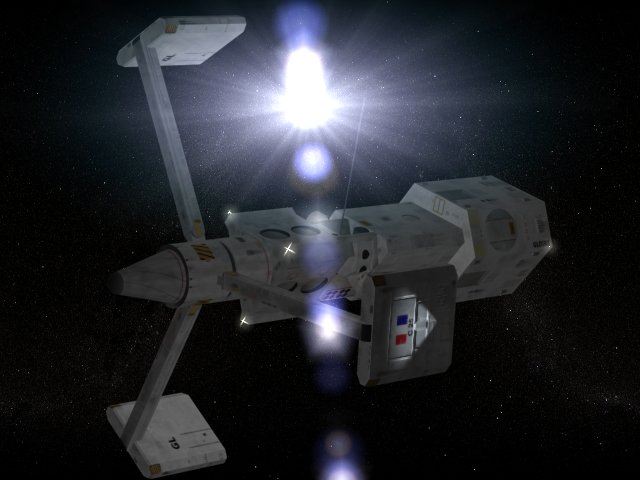
| Above: IFS Gloire
at QAS on its return from Operation ENTENTE.
Note the relative lack of battle damage
The Gloire was completed in the Autumn of 2289 and was to spend the next year undergoing trials and tests in the Alpha Centauri system. Many of these test were believed to be related to the performance of the new shielding systems and their effects on the missile control hardware on board the cruiser. This process revealed glitches which were eventually resolved and applied across the MSF's new warships. When finally accepted into the main force of the Fleet the Gloire was deployed to the 1st Fleet in the Sol system. It was in a time of uncertainty for France in the aftermath of the Central Asian War. Disputes with Manchuria remained in spite of the Armistice and the Gloire was involved in several bouts of 'shadow boxing' with Manchurian warships across the system. The long build-up to the War of German Reunification was a confusing period for the MSF in Sol. The old Bayerisch Stern Marine, the only serious German space force, was called to integrate into the new DSKM but its leadership remained ambivalent about both German-pressured Reunification and engaging their traditional French allies. Some ships, especially those far from Earth, rallied to the DSKM, some jumped sides to the French, but most removed themselves to Tirane or other German colonies for the duration. (Intriguingly the BSM flagship Bayern suffered several unaccountable security lapses allowing a team from I/2e REP to infiltrate and cripple this powerful warship. Rumours persist that the ship's Captain and a cabal of officers allowed this to happen rather than obey DSKM orders. None of these officers survived the attack and most of the commandos were killed with the destruction the Suffren in 2298. The truth of this allegation has yet to be confirmed.) As a result of this confusion at the heart of the BSM the MSF at Sol faced a much reduced enemy, but was hampered by the crowded nature of the system and OQZ restrictions. The DSKM engaged in a fleet-in-being strategy in the Sol system, pinning down a vast number of French ships which could have been more usefully utilised elsewhere. The Gloire took part in these frustrating cat and mouse operations throughout the short duration of hostilities. Although she was involved in the futile hunt for the German privateer/Q-ship Schlechter Nachrichten saw no direct fire action against DSKM forces. Below: IFS Gloire on operations near Jupiter during the hostilities in 2293. She is closed down for action, part of a cordon and search operation in response to a DSKM raid on French facilities on Ganymede
After the war the Gloire was deployed on a series of cruises along the Chinese Arm. These long, unglamorous operations were often accompanied by significant risk especially as the Manchurians resented the presence of French 'snooping' warships in 'their' systems. Consequently the Gloire and her escorts would often find themselves trailed by Manchurian warships. The Gloire would frequently operate above Heidelsheimat exercising with the rump Bavarian space forces as a highly visible symbol of France's backing for the colony. The 'Arcturus Problem' that was to become the Kafer War saw the Gloire withdrawn from her long vigils on the Chinese Arm, replacing Sol based units deploying to Eta Bootis. The destruction of the Gloire's sister ships Suffren and De Grasse was followed by the loss of the massive Ste. Jeanne d' Arc and a further five warships. This came as a massive blow to the MSIF which had managed to avoid the outright humiliations inflicted on the other French services by Germany, Manchuria and Elysian rebels. In spite of the reinforcement effort the Gloire was left to remain in the Sol system as she was tied up undergoing her ten year refit program from mid-2299 until late in 2300. The Invasion, heralded by the destruction of the German colony at Hochbaden, caused a re-deployment of the MSIF. Squadrons were dispatched to reinforce Admiral Rochemont's 3rd Fleet and the isolated force at Eta Bootis. Whilst her sister ships were sent up-Arm the Gloire was constantly overlooked and only when Kimanjano was assaulted did she travel up-arm to bolster the Reserve Fleet at QAS. Gloire arrived just in time to take part in Operation ENTENTE, the evacuation of the Kimanjano garrison. Combining with her sister Montcalm and the destroyers Dunkerque and Marechal Marsin they operated as a powerful force on the flank of the Allied force. This squadron played an important role in the 18 hour covering action that is rarely acknowledged in British accounts of the battle. Under her commander Capitaine Claire Girard the ship then combined with two American cruisers to form the rear-guard and during this duty rescued an escaping lander from Kimanjano orbit in an act of daring under the nose of the Kafers. It was an act for which Girard was both lauded and reprimanded. On their return to QAS the Gloire was involved in the protection of the system, a task complicated by the ceaseless politicking and bickering between the contingents and their commanders. During this time the Gloire was called upon to perform a secret mission in the Kimanjano system when it transferred a party of key personnel to one of Rochemont's privateers in that system before returning safely home. In the Battle of Beowulf the Gloire truly came of age, fighting as a part of the Prince of Wales Battle Group. This group of powerful and fast warships was Admiral Graham's trump card intervening in the battle at key points to swing the result of the battle. Time and again the PWBG was responsible for forcing the Kafers back, bolstering other hard pressed battle groups, using their firepower to finish off badly damaged alien craft or to defend the vital carrier group. The Gloire was individually responsible for destroying Epsilon-54, the 'Victory of the Enlightened' and sustained only superficial damage. As a result the Gloire was included in Graham's quick follow up and the 3rd Battle of Kimanjano that cemented the victory at Beowulf by scattering the Kafer survivors, destroying crippled warships and the vital replenishment train of transports. As ground forces were massed for an effort to liberate the colony the Gloire was involved in a series of mission in low orbits, bombarding key defensive locations and landing special forces from 1e RPIMa, USMC Force Recon and Azanian Recces. This experience was later called upon when the Liberation of Kimanjano began in earnest and the Gloire was tasked to deliver the vanguard of the attack. This is did, delivering the Groupement Étranger de Choc drawn from I/6e REI and the 101st Raider Company of the US Marines with an enhanced lander group of Zéniths. The ship remained on station for 15 hours providing orbital strike support and helping to break up several mobile Kafer assaults on the planethead before retiring. The Gloire would return to Kimanjano orbit several times and became well regarded by the ground troops for its aggression and willingness to take risks. The Liberation of Kimanjano was a fierce struggle and would last for several weeks before the final Kafer units were broken and Remnants still exist fighting a guerrilla war. The Gloire however was rapidly transferred to Rochemont's Fleet and was committed into the Eta Bootis finger. Whilst the eyes of the human race were focused on the liberation of the colony worlds, star forces were fighting a hundred small actions against the Kafers. Their fleets and squadrons might have been broken but the individual ships still fought hard, often suicidal battles. Girard's Gloire, with half of the 2e Batallion, Régiment Para-Commando embarked, was teamed up with the Marechal Ney, the British destroyer Invincible and a fluctuating handful of privateers to scour the finger. This team spent until the new year of 2303 traversing this bridge of stars running into numerous Kafer transports and minor warships. On two occasions they discovered Kafer capital ships and stalked them, calling in larger ships to aid them in the destruction of these ships. Most notable was the successful hunt for Beta-12 the 'Genocide of the Barbarians' that had killed HMS Rodney at the Battle of Beowulf. The Gloire's group was also involved in preliminary operations before the Liberation of Dunkelheim. So far in 2303 the Gloire has been an integral part of Rochemont's Fleet. Capitain Girard stands high in the estimations of both Rochemont and Graham (given the unenviable task of co-ordinating the human star forces) and consequently the Gloire is frequently called upon. Recently she has been the centrepiece of a group dispatched deep into the Wolf Cluster. |
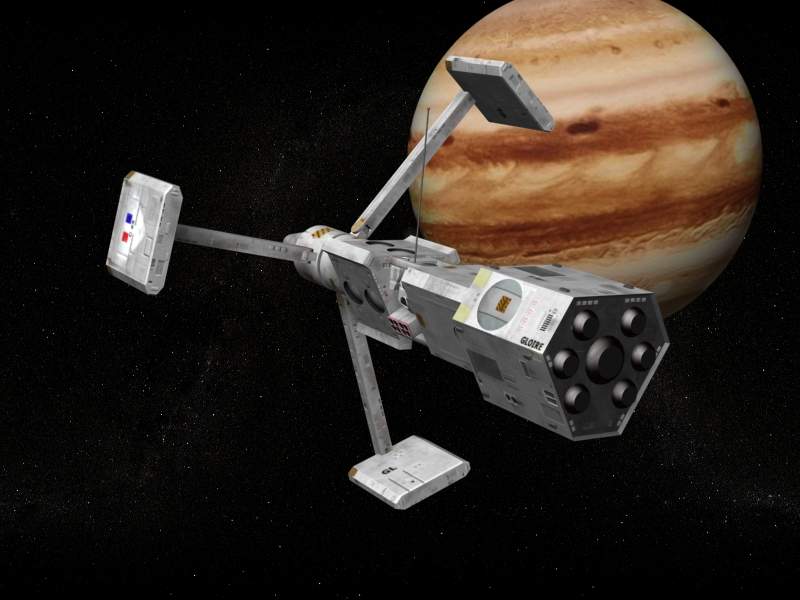
| Above: The Gloire
again near Jupiter during operations in 2293. Stats Performance Ship Status Sheet Weapons |
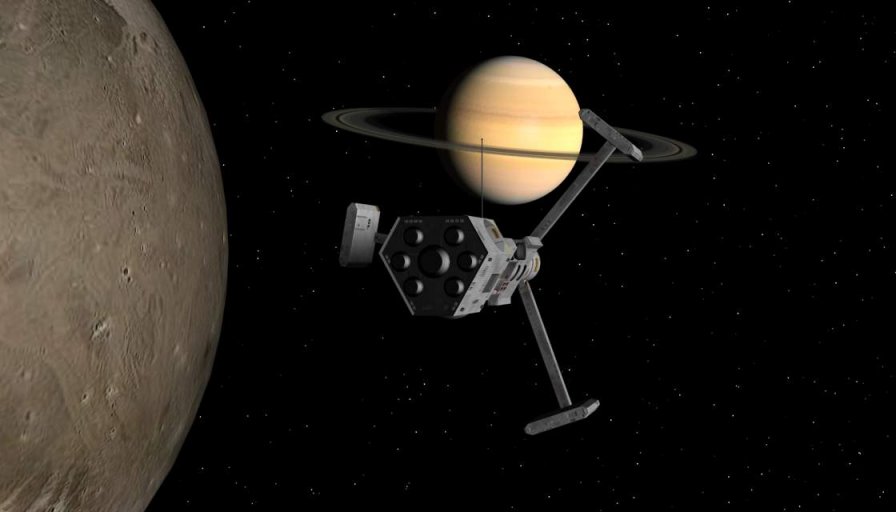
| Above: Gloire
on OQZ duties early in 2301. She had to maintain a high
tempo of operations due to the large number of MSIF ships
deployed on to the French Arm in response to Kafer
aggression
Capitaine de Frégate Claire Girard Claire Girard was born in Crystal Palace high above Terra, the daughter of the captain of the tramp freighter Etoile Rouge de Beograd which plied the trade routes of the Chinese and American arms and an unknown father. Her upbringing was mostly in the hands of her mother's extended family and took place in Earth orbit. She was a serious child, but one with an unconventional and mischievous streak. Her education was one suited to the scion of a merchant family, unfortunately the Etoile Rouge and all hands were lost without trace in 2281 in what was suspected to be a pirate attack. Claire, newly graduated from the Academy, was taken on by one of the many smaller companies and spent several years as crew on the freighter Profit Margin lumbering between Sol, the other Core worlds and Beowulf. This was a time of no little tension as Manchurian privateers conducted hit and run raids against merchant shipping across human space. The Profit Margin was on several occasions forced to run for its life, playing cat and mouse with Manchurian frigates in various un-patrolled system. Claire left the Profit Margin in 2285 when she discovered she was pregnant and consequently took a year off returning to Crystal Palace. It was there that she decided to join the MSF, having become tired of being on the receiving end of raids. Already a competent pilot and navigator she progressed rapidly serving, as Helm-2 on the Marechal Foch before becoming Nav-1 on the Surcouf on which vessel she served during the War of German Reunification. In these positions she quickly became well regarded for her knowledge of privateer tactics which were utilised both in convoy escort tasks and on occasions when called upon to interdict enemy merchants. She was fortunate that most of her service was undertaken in the Sol system and she was able to see her daughter frequently. However in late 2294 she was approached by MSF Intelligence to take on a secret task on the Chinese Arm as the captain of a Q-Ship operation designed to track and trap pirates and hijackers then plaguing the area. Details of her four years in charge of the Vilain Petit Canard, a freighter whose firepower reputedly would shame a destroyer, are still classified (although occasional mention of the craft's exploits could be found in the Canadian and Manchurian press.) In any event her superiors seemed satisfied and she was sent on the two year 'Space Warfare' course in preparation for command of a warship. Originally she was supposed to take command of one of the Marechal's but the unexpected death of one of her rivals (and patronage of an influential MSIF admiral saw her given command of the Gloire when it emerged from refit. So far as Capitain she has not put a foot wrong in charge of the Gloire. Although initially her free-wheeling and almost maverick style put her at odds with the more conventional senior members of her crew (not to mention superior officers). These individuals still mistrust her but the more junior members of the crew increasingly regard her with a sense of awe and the beginnings of hero worship. Unfortunately though her personal life is in tatters, and she has become increasingly estranged from her teenage daughter. Maitre Principal Jean-Pierre Kanza Born in the slums of Libreville Jean-Pierre Kanza is an unlikely candidate to become the senior Helm of one of the most powerful cruisers in the MSIF. His early life was a hard one, not helped by his fathers frequent absences in jail as a result of his radical anti-French Union politics. Kanza fell into a life of petty crime and almost inevitably was caught and sent to a young offenders prison. It was there that he received his first real education and proved an exceptionally able student. Indeed at the end of his sentence he was rewarded with a scholarship to a prestigious lycée in Senegal. There he became to appreciate the French Union for the opportunities it could provide and utterly renounced his father’s radical politics. As he approached the end of his schooling he attempted to enter the Armée de l’Air, however his aptitude tests were of such a high level that he was referred on to the MSF. They in turn enabled him to enter the Grande Ecole des Etoiles at Gateway, and four years later he joined the MSF proper. After his basic training he was streamed into the fighter branch and began his service with GCS 3-2 (Groupe de Chasse Spatial 3, 2e Escadron) in 2287. Serving in a number of stations Kanza came into contact with Manchurian privateers on several occasions, he also served a tour above Elysia. Kanza was quickly marked out as an exceptional pilot with a keenly developed sense of spatial awareness, but proved less able as an administrator. Kanza served as senior pilot in GCS 2 which was based at Kimanjano during the War with Germany, and gained valuable experience against German raiders. In later years he was then brought in to the Centre d'Essais en Vol above Tirane as one of the staff test pilots work in developing tactical doctrine for the Bufer, however a clash of personalities resulted in Kanza being removed from his position early. Denied a position back with the fighter branch he was instead moved into line ships. Initially serving with the Aconit class Courbet where he would first meet Claire Girard whilst she was training for ship command. Although the two came from substantially different backgrounds they worked as an effective team. Later when she took command of the Gloire she pulled as many strings as possible to get Kanza assigned as Helm-1. The tall, well built Kanza is an audacious, instinctive, but also highly dedicated pilot. He is an ardent French nationalist, although he despises the internal politicking that mars the effectiveness of the MSIF. His views are forthright and can alienate many other members of the crew, and although he rarely agrees completely with his Captain there is mutual respect on both sides. Enseigne Jean Rochemont Ens Rochemont is a nephew of Admiral Rochemont and is currently assigned to the Gloire as the Nav-2. Born and raised in Paris Rochemont has had a privileged upbringing as his father had a key role in the Quai d’Orsay. This changed when his father was pushed out of officer by the Junta as he was seen as one of the architects of the failed policies that caused the Central Asian War. However he soon received a sinecure position with the Rouchard-Ligget conglomerate. Young Jean grew up very aware of the role of politics and personalities in the workings of the French state. He was educated in Lycée Henry IV where he gained excellent grades and intended to serve for a term in the MSIF before moving into business. His grades in the entrance exams were rather poor but he still managed to gain entrance into the MSIF's academy. On graduation from the academy he served briefly on Le Gascon before being transferred to the Gloire just before its move to Beowulf. Tall, good looking and highly educated Rochemont is an inexperienced officer having to learn his job the hard way. His plans for a career in business have been put on hold as the Gloire becomes increasingly involved in the war. He realises he is out of his depth but does his best to overcome his lack of inspiration by hard work. He has had contact with his uncle who as offered a position as an aide de camp but Rochemont has so far turned this down to remain with the ship. Commandant Ismail Soltani Commandant Soltani is the second in command of the 2/ Régiment Para-Commando. He is the OC of the two companies of 2/Para-Cdo and CW detachment from the FULVOLMARS currently assigned as the embarked troops for the Gloire. They have been teamed up since their assignment to operations in the Eta Bootis finger and lately in the Wolf Cluster. Soltani was born in the industrial northern French town of Lille. He was a mediocre student but an excellent sportsman. He joined the Troupes de Marine when he left school as a private soldier, and was assigned to the Para-Commandos, a mainly Walloon regiment. He soon saw service in the 'peacekeeping' mission in the Central Asian Republic, acting as a fire brigade the Para-Commandos saw frequent action. In 2289 the regiment was involved in the Colonel's Coup that brought in the Junta, helping to seize key points around Paris. Soltani became an Officier-Aspirant and was soon commissioned. The Junta was keen to get the often rebellious Para-Commandos away from France and they were sent to man a rotation of posts on Tirane and the other French Arm worlds. However they were called into action with the other regiments of the Troupes d' Intervention Spatial to spearhead French resistance to the Kafers and served a tour on Aurore before the Invasion. As a part of the 4e BI they fought with Rochemont's Fleet, most notably on Crater and Beta Canum-4, in the dark days before the triumph at Beowulf. 2 Para-Cdo are truly a battle-hardened elite, vocal in their scorn of the claims of other units both French and foreign. Soltani has earned his rank in combat (specifically on the bloody DZ at Rimview), stepping up to fill the shoes of dead men and surviving in the thick of battle. Of distant Algerian descent he is powerfully built, a keen tactician and a charismatic leader. Highly regarded by his men he is the only authority his troops accept, much to the irritation of the Gloire's crew who are also proud their own reputation. Clashes have been kept under control only by strict discipline which Soltani is happy to apply, although he allows his men off the leash on leave. Soltani sees himself as following on the tradition of larger-than-life French para commanders. Above: IFS Gloire pictured above Africa early in 2287 transitioning to action stations in response to a OQZ violation. Note the stutterwarp compensation revealing that the escorting Martels have already engaged their drives. |
